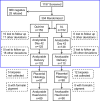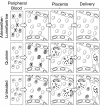Artemether-lumefantrine to treat malaria in pregnancy is associated with reduced placental haemozoin deposition compared to quinine in a randomized controlled trial
- PMID: 22554092
- PMCID: PMC3487992
- DOI: 10.1186/1475-2875-11-150
Artemether-lumefantrine to treat malaria in pregnancy is associated with reduced placental haemozoin deposition compared to quinine in a randomized controlled trial
Abstract
Background: Data on efficacy of artemisinin-based combination therapy (ACT) to treat Plasmodium falciparum during pregnancy in sub-Saharan Africa is scarce. A recent open label, randomized controlled trial in Mbarara, Uganda demonstrated that artemether-lumefantrine (AL) is not inferior to quinine to treat uncomplicated malaria in pregnancy. Haemozoin can persist in the placenta following clearance of parasites, however there is no data whether ACT can influence the amount of haemozoin or the dynamics of haemozoin clearance.
Methods: Women attending antenatal clinics with weekly screening and positive blood smears by microscopy were eligible to participate in the trial and were followed to delivery. Placental haemozoin deposition and inflammation were assessed by histology. To determine whether AL was associated with increased haemozoin clearance, population haemozoin clearance curves were calculated based on the longitudinal data.
Results: Of 152 women enrolled in each arm, there were 97 and 98 placental biopsies obtained in the AL and quinine arms, respectively. AL was associated with decreased rates of moderate to high grade haemozoin deposition (13.3% versus 25.8%), which remained significant after correcting for gravidity, time of infection, re-infection, and parasitaemia. The amount of haemozoin proportionately decreased with the duration of time between treatment and delivery and this decline was greater in the AL arm. Haemozoin was not detected in one third of biopsies and the prevalence of inflammation was low, reflecting the efficacy of antenatal care with early detection and prompt treatment of malaria.
Conclusions: Placental haemozoin deposition was decreased in the AL arm demonstrating a relationship between pharmacological properties of drug to treat antenatal malaria and placental pathology at delivery. Histology may be considered an informative outcome for clinical trials to evaluate malaria control in pregnancy.
Registry: http://clinicaltrials.gov/ct2/show/NCT00495508.
Figures





References
-
- Dondorp A, Nosten F, Stepniewska K, Day N, White N. Artesunate versus quinine for treatment of severe falciparum malaria: a randomised trial. Lancet. 2005;366:717–725. - PubMed
-
- Dondorp AM, Fanello CI, Hendriksen IC, Gomes E, Seni A, Chhaganlal KD, Bojang K, Olaosebikan R, Anunobi N, Maitland K. et al.Artesunate versus quinine in the treatment of severe falciparum malaria in African children (AQUAMAT): an open-label, randomised trial. Lancet. 2010;376:1647–1657. doi: 10.1016/S0140-6736(10)61924-1. - DOI - PMC - PubMed
-
- WHO. Guidelines for the treatment of malaria. 2. World Health Organization, Geneva; 2010. - PubMed
-
- McGready R, Cho T, Samuel, Villegas L, Brockman A, van Vugt M, Looareesuwan S, White NJ, Nosten F. Randomized comparison of quinine-clindamycin versus artesunate in the treatment of falciparum malaria in pregnancy. Trans R Soc Trop Med Hyg. 2001;95:651–656. doi: 10.1016/S0035-9203(01)90106-3. - DOI - PubMed
Publication types
MeSH terms
Substances
Associated data
Grants and funding
LinkOut - more resources
Full Text Sources
Medical

